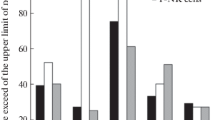Abstract
The reactivity of peripheral blood leukocytes to Epstein-Barr virus-associated antigen was assessed employing twoin vitro tests, leukocyte adherence inhibition (LAI) and leukocyte migration inhibition (LMI). In both tests, autologous serum from some normal subjects was shown to confer strong reactivity on weak or non-responder cells. Reactivity to purified protein derivative of tuberculin (PPD) assessed in parallel was shown to be unaffected by autologous serum. Employing the LAI system, variations in the effects of autologous serum samples collected on consecutive days was shown to be dependent on the reactivity of the leukocytes themselves, rather than changes in the activity or concentration of factors present in the serum.
Similar content being viewed by others
References
Andersson, L. C., Hayry, P., Bach, M. A., Bach, J. F.: Differences in the effects of adult thymectomy on T-cell mediated responsesin vitro. Nature (Lond.)252; 252–254 (1974)
Dennert, G.: Evidence for Non-identity of T-killer and T-helper colls sensitised to allogenic cell antigens. Nature (Lond.)249, 358–360 (1974)
Eardley, D. D., Stakawicz, M. O., Gershon, R. K.: Suppressor cells: dependence on assay conditions for functional activity. J. exp. Med.143, 1211–1219 (1976)
Fimmel, P. J.: Studies on leukocyte migration inhibition: The role of E-rosette-forming cells in specific antigen-induced inhibition of migration. J. Immunol.115, 135–138 (1975)
Fimmel, P. J., Keast, D.: Studies onin vitro leucocyte migration inhibition. Aust. J. exp. Biol. Med. Sci.52, 745–753 (1974)
Fimmel, P. J., Keast, D.:In vitro cell-mediated immunity and serum blocking factors specific for Epstein-Barr Virus in infectious mononucleosis. I.R.C.S.2, 1296 (1974)
Fimmel, P. J., Lai, P. K., Keast, D., Alpers, M. P., Mackay-Scollay, E. M.:In vitro cellular immunity to Epstein-Barr virus in normal human subjects. Int. J. Cancer13, 599–605 (1974)
Hellstrom, I., Hellstrom, K. E., Warner, G. A.: Increase of lymphocyte-mediated tumour-cell destruction by certain patient sera. Int. J. Cancer12, 348–353 (1973)
Hinuma, Y., Kohn, M., Yamaguchi, Y., Wudarski, D. J., Blakeslee, J. R., Grace, J. T.: Immunofluorescence and Herpes-type virus particles in the P3HR-1 Burkitt lymphoma cell line. J. Virol.1, 1045–1051 (1967)
Holt, P. G., Chalmer, J., Roberts, L. M., Keast, D.: Development of two manifestations of T-lymphocyte reactivity during tumour growth: altered kinetics associated with elevated growth rates. J. nat. Cancer Inst.55, 1135–1142 (1975)
Holt, P. G., Fimmel, P. J., Roberts, L. M., Bartholomaeus, W. N., Tandon, M. K., Keast, D.: Dissociation of correlates of cellular immunity in man: functional heterogeneity within the antigen-reactive cell population? In. Arch. Allerg. appl. Immunol.51, 560–573 (1976)
Holt, P. G., Roberts, L. M., Fimmel, P. J., Keast, D.: The LAI microtest: A rapid and sensitive procedure for the demonstration of cell-mediated immunityin vitro. J. Immunol. Methods8, 277–288 (1975)
Janeway, C. A., Sharrow, S. D., Simpson, E.: T-cell populations with different functions. Nature (Lond.)253, 544–546 (1975)
Lai, P. K., Mackay-Scollay, E. M., Fimmel, P. J., Alpers, M. P., Keast, D.: Cell-mediated immunity to Epstein-Barr virus and a Blocking factor in patients with infectious mono-nucleosis. Nature (Lond.)252, 608–610 (1974)
Perlmann, P., Holm, G.: Cytotoxic effects of lymphoid cellsin vitro. Advanc. Immunol.11, 117–193 (1969)
Pulvertaft, J. V.: A study of malignant tumours in Nigeria by short-term tissue culture. J. clin. Path.18, 261–273 (1965)
Rocklin, R. E.: Techniques for assessing delayed hypersensitivityin vitro. In: Progress in Immunology II (L. Brent and J. Holborow eds.) vol. 3, p. 366. North-Holland Publishing Co., 1974
Suzuki, M., Hinuma, Y.: Evaluation of Epstein-Barr virus-associated nuclear antigen with various human cell lines. Int. J. Cancer14, 753–761 (1974)
Author information
Authors and Affiliations
Rights and permissions
About this article
Cite this article
Holt, P.G., Fimmel, P.J., Roberts, L.M. et al. Serum modulation ofin vitro cellular immune reactivity to Epstein-Barr virus-associated antigen. Med Microbiol Immunol 162, 209–216 (1976). https://doi.org/10.1007/BF02120999
Received:
Issue Date:
DOI: https://doi.org/10.1007/BF02120999




